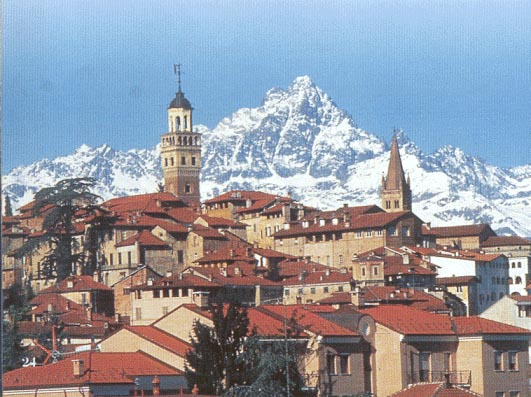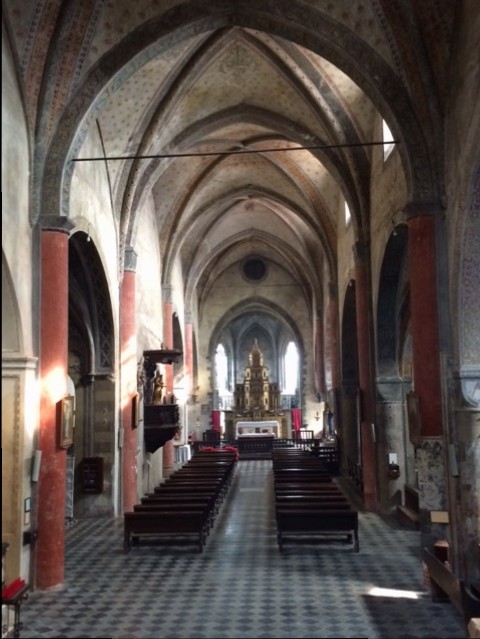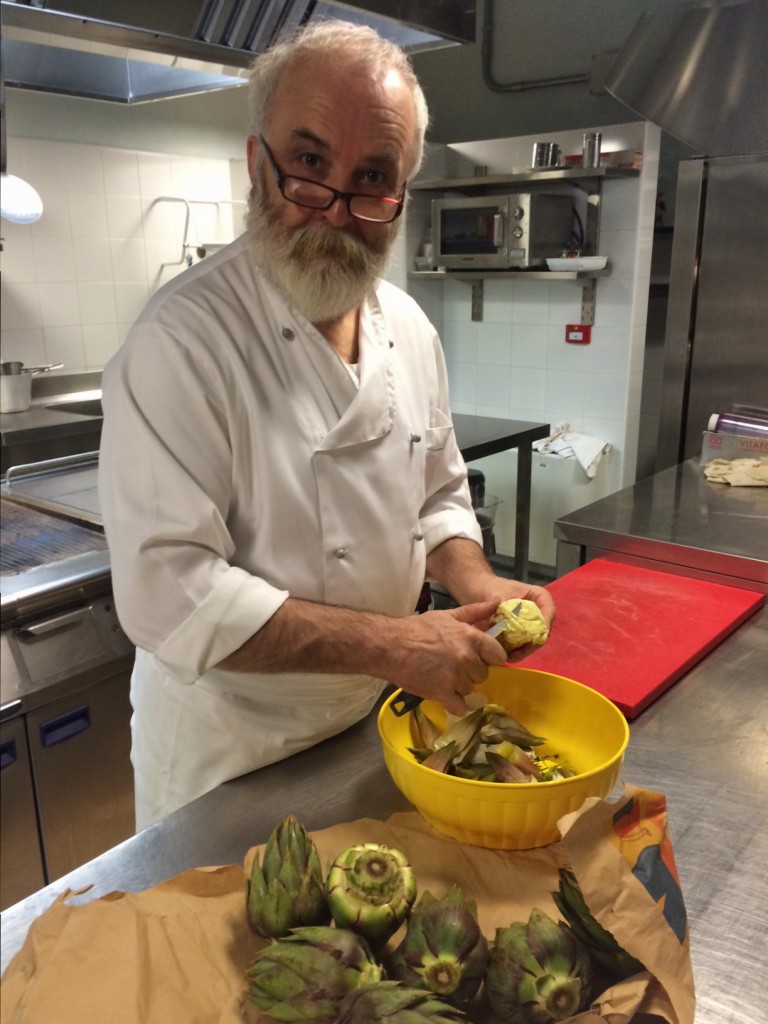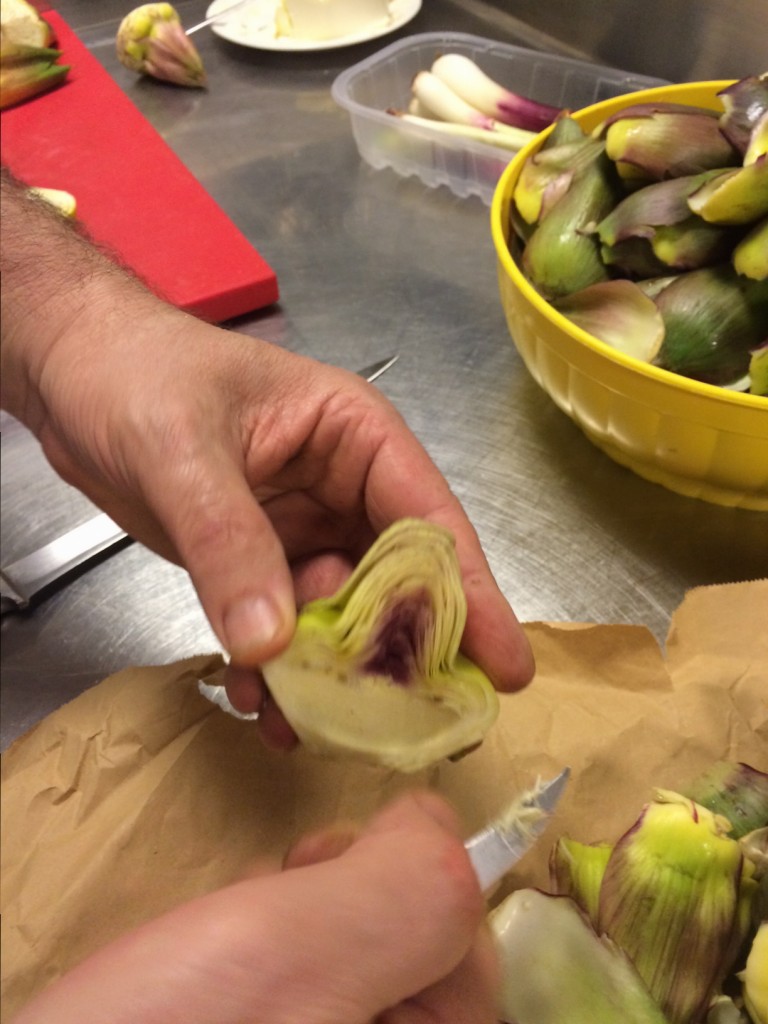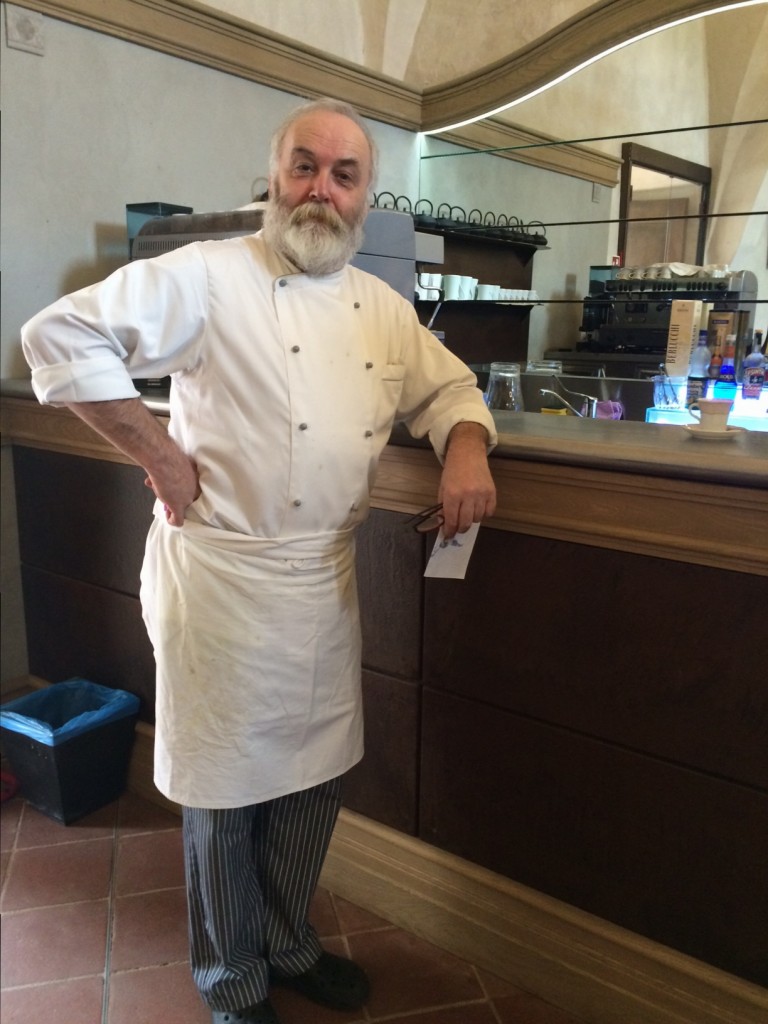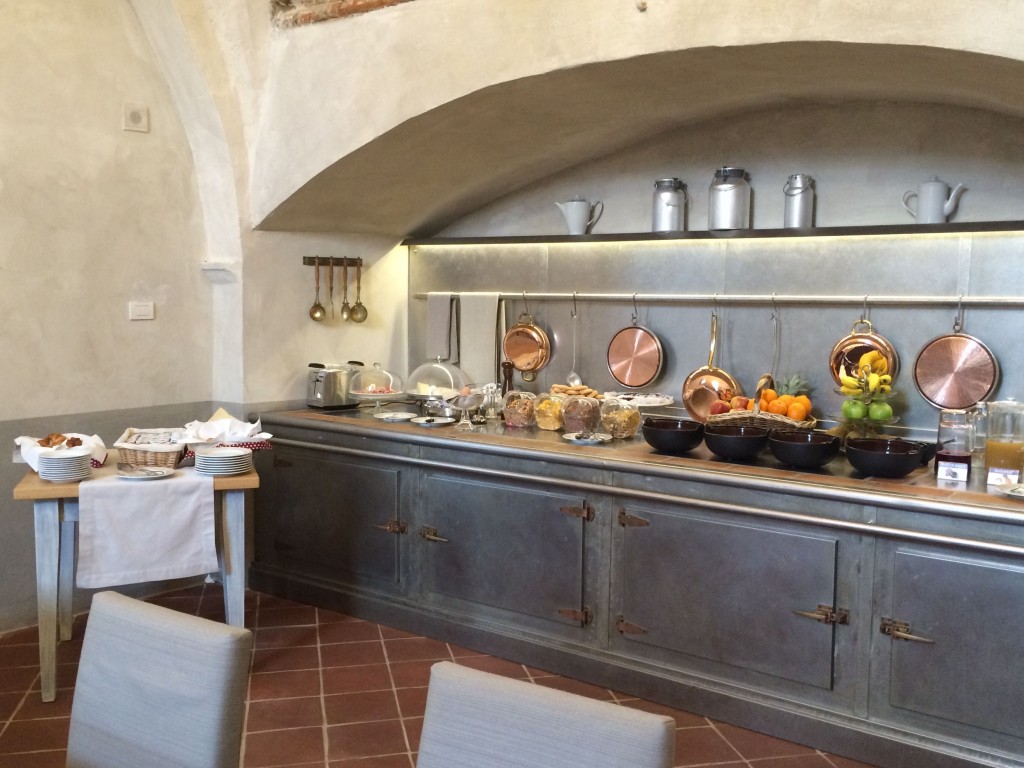On Peeling Artichokes (& Potatoes) in Saluzzo
I’m standing in the spotless kitchen of Piero Boaglio, chef at the San Giovanni Hotel De Charme in Saluzzo, a picture-book medieval town in northern Italy and seat of an ancient courtly Marquisate founded in 1142.
I’d stumbled across the hotel while looking for somewhere to have coffee on my way up to the 13th century castiglia (castle) on top of the hill. Having arrived early by bus on a Saturday morning, I’d checked out the enormous bustling market sprawled around the Cathedral (and even crept inside and witnessed Communion) before setting off to the more ancient part of the city inside the walls.
It was there, through an archway, that I spotted the mercato delle donne (women’s market) a tiny market in the Piazetta Santa Maria where local women sell their home-grown fruits, vegetables and preserves. And it was from there that I set off up the hill along the via Volta, up the steps around Piazetta Mondagli and then along the sloping Salita al Castello to the top.
But I was too early.
“It opens at 10am,” said the guard at the door. When I asked him where I could get a coffee, he pointed down the hill and muttered something about a bar in a hotel near the church of San Giovanni. The church wasn’t far, but I couldn’t see the hotel.
A group of Italian tourists had just exited the church, so I decided to go in and see what they seemed to be so excited about. As soon as I entered the hushed space, it was clear this 14th century Dominican church was rich in art and history.
I fell instantly in love with the 15th century frescoes by Pietro da Saluzzo on both sides of the entrance, and was amused to see Ludovico II ornately displayed as a medieval knight in the apse (Capella dei Marchesi).
But where was that bar?
I finally found it tucked away further down the hill under an archway with a discreet oval sign over the top which said San Giovanni Hotel Resort. A few cars were parked outside so I pushed the door open, and there to my right, inside the stunning lobby was a bar.
I was reluctant to ask the woman at the front desk just for a coffee, but she was happy to oblige and when I told her I was studying at the University in Pollenzo, she asked if I’d like to meet their chef.
How could I refuse? Given that nothing opened until 10am, I was in no hurry.
She took me down in a lift and along a narrow corridor which led to the kitchen of the restaurant, aptly called Al Convento. The hotel was once a monastery for Dominican monks and I could feel their presence down here.
Piero Boaglio was busy peeling carciofi (artichokes) for the Saturday evening meal when I arrived.
He looked up from under his glasses and welcomed me. I could tell he was busy doing his mise-en-place and told him I was happy to watch him working.
I’ve seen some beauties in the markets over the past few weeks, and these were plump and vibrant. He began by roughly tearing off their tough outer leaves, then cut them in half, removed their hairy chokes (with a small paring knife), and dropped them in a basin of water.
“No need for lemon juice (to prevent browning),” he told me. “Because I’m using them straight away.”
Once they were all in the water, he took them out one by one and sliced them finely. They were tossed into large frying pan in which some finely sliced long red Tropea onions had been sautéed with oil and butter (white, not yellow), then added the artichokes.
He flipped them around a few times before leaving them to finish cooking over medium-high heat. They would later accompany the fish dish Filetto di Ombrina e Carciofi.
Then it was on to the potatoes (those delicious mountain potatoes so abundant in northern Italy). They’d been par-boiled and he was peeling them one by one to make “pommes duchesse”.“The work of a chef is to peel potatoes,” he told me.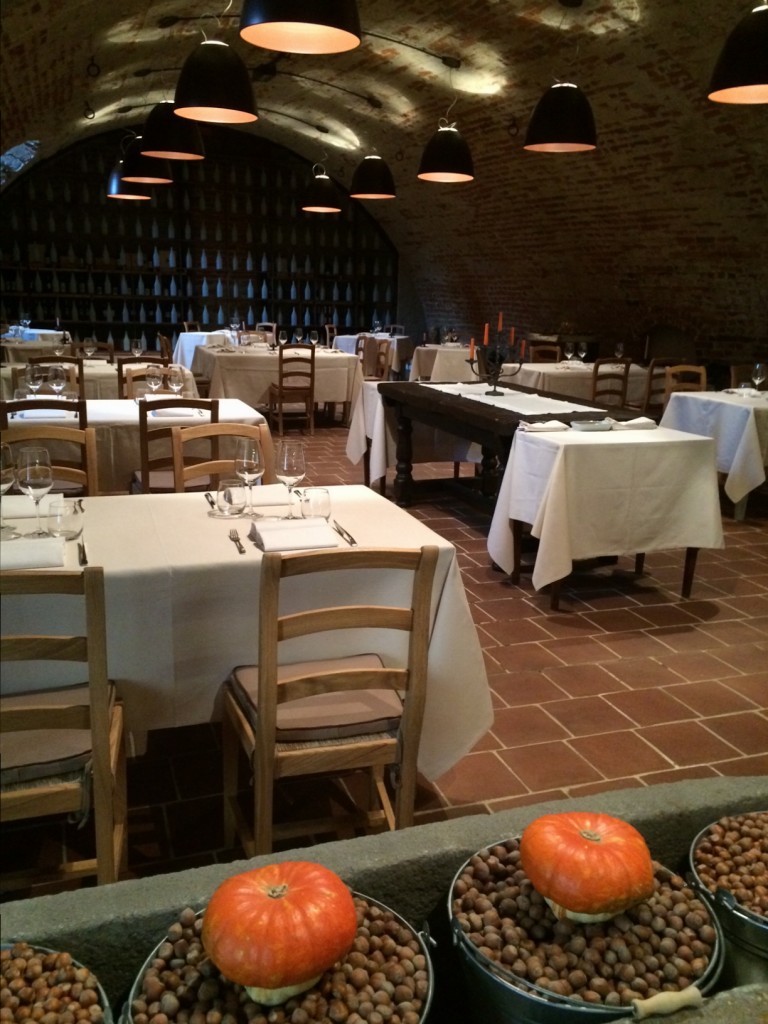 “It’s not about going on TV and becoming a celebrity MasterChef. That’s not real because everything’s fixed. It’s not the life of a real chef.
“Italians have become stupid,” he continued. “They no longer know what to eat. Years ago, people would arrived in a restaurant and ask what was on the menu that day. And they’d sit down and eat what the chef had prepared.”
Once the potatoes were peeled, he pushed them through a potato ricer, added a couple of egg yolks, some chopped fresh parsley, salt and pepper, gave them a good whisk and set them aside for later. They would be served later with
When Piero learnt to cook at Alberghiero di Pinerolo in Turin 40 years ago, he was taught to cook French food. “We learnt all the French terminology, sauces, techniques,” he said.
“The word chef is French – in Italian it’s capo. Back then the French were number one and we learnt everything from them, but today Italian food and wine is the best. We’ve learnt new techniques and there is more diversity in Italy.
“Every region and province here has its speciality. It’s not monotonous like the French cuisine.”
As I walked back up hill to the castle, I mused on my good luck at meeting such a dedicated, hard-working Saluzzese (Saluzzo citizen), and wondered what the Dukes of Savoy (and France’s 21st century chefs) would think of this 21st century Italian chef (sorry, capo).
Postscript: on a similar theme, check out what the Master of Italian Cooking, Gualtiero Marchesi, has to say about the role of the chef in an era of competitive cooking shows here.
“It’s not about going on TV and becoming a celebrity MasterChef. That’s not real because everything’s fixed. It’s not the life of a real chef.
“Italians have become stupid,” he continued. “They no longer know what to eat. Years ago, people would arrived in a restaurant and ask what was on the menu that day. And they’d sit down and eat what the chef had prepared.”
Once the potatoes were peeled, he pushed them through a potato ricer, added a couple of egg yolks, some chopped fresh parsley, salt and pepper, gave them a good whisk and set them aside for later. They would be served later with
When Piero learnt to cook at Alberghiero di Pinerolo in Turin 40 years ago, he was taught to cook French food. “We learnt all the French terminology, sauces, techniques,” he said.
“The word chef is French – in Italian it’s capo. Back then the French were number one and we learnt everything from them, but today Italian food and wine is the best. We’ve learnt new techniques and there is more diversity in Italy.
“Every region and province here has its speciality. It’s not monotonous like the French cuisine.”
As I walked back up hill to the castle, I mused on my good luck at meeting such a dedicated, hard-working Saluzzese (Saluzzo citizen), and wondered what the Dukes of Savoy (and France’s 21st century chefs) would think of this 21st century Italian chef (sorry, capo).
Postscript: on a similar theme, check out what the Master of Italian Cooking, Gualtiero Marchesi, has to say about the role of the chef in an era of competitive cooking shows here.
 “It’s not about going on TV and becoming a celebrity MasterChef. That’s not real because everything’s fixed. It’s not the life of a real chef.
“Italians have become stupid,” he continued. “They no longer know what to eat. Years ago, people would arrived in a restaurant and ask what was on the menu that day. And they’d sit down and eat what the chef had prepared.”
Once the potatoes were peeled, he pushed them through a potato ricer, added a couple of egg yolks, some chopped fresh parsley, salt and pepper, gave them a good whisk and set them aside for later. They would be served later with
When Piero learnt to cook at Alberghiero di Pinerolo in Turin 40 years ago, he was taught to cook French food. “We learnt all the French terminology, sauces, techniques,” he said.
“The word chef is French – in Italian it’s capo. Back then the French were number one and we learnt everything from them, but today Italian food and wine is the best. We’ve learnt new techniques and there is more diversity in Italy.
“Every region and province here has its speciality. It’s not monotonous like the French cuisine.”
As I walked back up hill to the castle, I mused on my good luck at meeting such a dedicated, hard-working Saluzzese (Saluzzo citizen), and wondered what the Dukes of Savoy (and France’s 21st century chefs) would think of this 21st century Italian chef (sorry, capo).
Postscript: on a similar theme, check out what the Master of Italian Cooking, Gualtiero Marchesi, has to say about the role of the chef in an era of competitive cooking shows here.
“It’s not about going on TV and becoming a celebrity MasterChef. That’s not real because everything’s fixed. It’s not the life of a real chef.
“Italians have become stupid,” he continued. “They no longer know what to eat. Years ago, people would arrived in a restaurant and ask what was on the menu that day. And they’d sit down and eat what the chef had prepared.”
Once the potatoes were peeled, he pushed them through a potato ricer, added a couple of egg yolks, some chopped fresh parsley, salt and pepper, gave them a good whisk and set them aside for later. They would be served later with
When Piero learnt to cook at Alberghiero di Pinerolo in Turin 40 years ago, he was taught to cook French food. “We learnt all the French terminology, sauces, techniques,” he said.
“The word chef is French – in Italian it’s capo. Back then the French were number one and we learnt everything from them, but today Italian food and wine is the best. We’ve learnt new techniques and there is more diversity in Italy.
“Every region and province here has its speciality. It’s not monotonous like the French cuisine.”
As I walked back up hill to the castle, I mused on my good luck at meeting such a dedicated, hard-working Saluzzese (Saluzzo citizen), and wondered what the Dukes of Savoy (and France’s 21st century chefs) would think of this 21st century Italian chef (sorry, capo).
Postscript: on a similar theme, check out what the Master of Italian Cooking, Gualtiero Marchesi, has to say about the role of the chef in an era of competitive cooking shows here.
